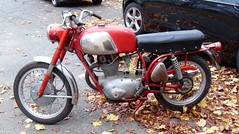sign216
Member
I'd like to modify Velleman's transistor assisted ignition kit, so that it can be used with a modern high performance ignition coil. This would put 8.6 amps to the kit's transistors (2N2219A and TIP162 or BU319P). Can these transistors take it?
The kit is designed for an induction ignition coil for breaker points, approx. 1.5 to 3.0 ohms, which limits current to 4 amps.
12v / 3 ohms = 4 amps
The 4 amps limit is for the breaker points, which erode under higher amperage.
The transistor kit makes the breaker points a mere switch, with the transistor handling the real load. With the points gone, I can use a modern high performance coil (0.7 ohms). A high performance coil gives more spark to the spark plug, a real benefit. But then the kit is taking over it's 4 amps design.
My vehicle is an antique motorcycle with a 6v system, so the kit would get 8.6 amps instead of 4 amps.
6v / 07. ohms = 8.6 amps
On the Velleman forum a company representative replied to this question some time ago. They said two things;
1. The kit has a max input of 4amps. This limit is controlled by the transistor rating.
2. The kit was designed 30 yrs ago by a man who's no longer present, so they can't answer many technical questions.
Can the kit's transistors (2N2219A and TIP162 or BU319P) handle 8.6 amps?
Joe
The kit is designed for an induction ignition coil for breaker points, approx. 1.5 to 3.0 ohms, which limits current to 4 amps.
12v / 3 ohms = 4 amps
The 4 amps limit is for the breaker points, which erode under higher amperage.
The transistor kit makes the breaker points a mere switch, with the transistor handling the real load. With the points gone, I can use a modern high performance coil (0.7 ohms). A high performance coil gives more spark to the spark plug, a real benefit. But then the kit is taking over it's 4 amps design.
My vehicle is an antique motorcycle with a 6v system, so the kit would get 8.6 amps instead of 4 amps.
6v / 07. ohms = 8.6 amps
On the Velleman forum a company representative replied to this question some time ago. They said two things;
1. The kit has a max input of 4amps. This limit is controlled by the transistor rating.
2. The kit was designed 30 yrs ago by a man who's no longer present, so they can't answer many technical questions.
Can the kit's transistors (2N2219A and TIP162 or BU319P) handle 8.6 amps?
Joe



